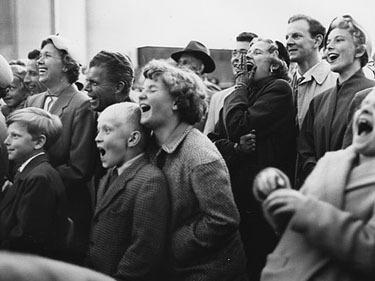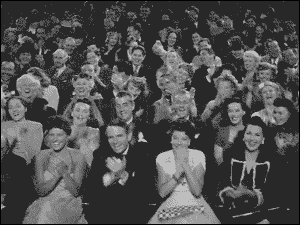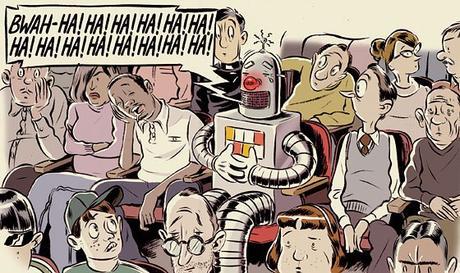 Teaching American Humor: Laughing with Laugh Tracks
Teaching American Humor: Laughing with Laugh Tracks My life would be better with a laugh track. My writing would be better, too. So would your reading experience-well, with a laugh track and a few drinks...
I am with the majority opinion on this issue, at least according to most producers of American situation comedies for the last sixty years. The reasoning behind the laugh track, as I see it, goes like this: A laugh track makes people laugh; people who laugh enjoy situation comedies; people who enjoy situation comedies see plenty of commercials; people who see commercials while in a good mood tend to buy things; a laugh track makes people laugh, and so on... Those who buy and sell commercials fund sitcoms, and they have never been inclined to trust writers or audiences. Neither do I.
I have skillfully written two first-rate jokes thus far. But, of course, you can't really know that because this post does not have a laugh track. I spent several hours trying to insert laugh track audio here and failed. That's funny-I think-but how can any of us be sure?

Teaching the American sitcom requires some discussion of laugh tracks. I admit that I have only glossed over laugh tracks in courses on American humor thus far. This has been a mistake. I have awakened to an obvious point: laugh tracks provide a compelling way for students to consider a more challenging array of characteristics of the art form-from the aesthetic to the mundane, from the heart of performance to the mechanics of production, from the implicit honesty of comedy to the manipulative potential of technology. From now on, I will begin all coursework focused on the sitcom with the laugh track.
Here is how I came to this astounding awakening; it's all about The Big Bang Theory. I like the show (though I can't decide whether I should consider it a "guilty pleasure" or an appreciation of solid, if broad, writing). The laugh track, however, drives me crazy. It is loud and intrusive. I don't believe it at all. I am not alone. Any quick Google search of "laugh tracks" will provide over 31,000,000 hits. Type in "Big Bang Theory," and you will find 127,000,000 hits, virtually all of which refer to the show (I didn't check out all of them, by the way. I simply reached that conclusion using the scientific method based on my observations of the first two pages). Here is a fact: lots of people care about the television show; almost nobody cares about the scientific theory. A search of the show title combined with "laugh tracks" gets 181,000 hits. Lots of people hate the laugh track (lots of people hate the show, too). YouTube has plenty of clips of the show with the laugh track removed. Here are two examples:
http://www.youtube.com/watch?v=PmLQaTcViOA http://www.youtube.com/watch?v=ASZ8Hks4gkoThese clips draw out two basic responses from interested parties: one, that the show is hurt by the laugh track (so the complaint concerns its use rather than the inherent quality of the show itself); two, that the laugh track lamely attempts to cover up a lousy show. There is no reconciling of these opposing positions, but the removal of the laugh track is disingenuous in that it creates a show wherein the comedic timing has been wholly distorted. The Big Bang Theory is filmed in front of a live audience, and the performance reflects the interaction between audience and cast. The producers of the show claim that the audience responses are genuine and have not been "sweetened," a term to imply that the laughter has been engineered in production to enhance audience responses. This claim is disingenuous as well. Any production process will inevitably "sweeten" the final product-from placement of microphones to volume applied. All steps in the process of preparing a show for airing are a form of "sweetening." Simply because the producers do not use canned laughter (laughter recordings NOT from an live audience) does not mean that no laughter manipulation occurs. Of course it does. As always, The Onion provides the best satirical take on laugh tracks with the show by simply raising the volume of the laugh track so that it wholly overpowers the show itself: Big Bang Theory with laugh track enhanced by The Onion
Why do producers of sitcoms still believe in the laugh track? This question implies a long and complicated discussion beyond me at this point. The most popular shows still use laugh tracks. Two sources, however, provide a good overview that can be useful in the classroom. On the Media offered a segment that first aired in January 2012 discussing the use of the laugh track.
Here is a link to its website:
http://www.onthemedia.org/2012/jan/06/laugh-track/Also, Josef Adalian has a solid essay in New York Magazine online (he is also interviewed in the On the Media podcast):

Click illustration to head to article.
For this space, I will simply state an optimistic if obvious justification for the laugh track. As odd of a concept as it is, the laugh track exists simply because everybody knows laughter is contagious. And shared laughter is life affirming. That is most often pleasant to audiences sitting at home in front of the television; it is also useful to advertisers. That's called a "win-win."
One of the most interesting ways to explore the importance of the laugh track to the sitcom is to take advantage of parody by getting students to talk about laugh tracks as they explore mash-ups of laugh tracks applied to television dramas. The best example I have found first appeared on Funny or Die. Sacha Proctor applies an opening title sequence and then a laugh track to scenes from one of the darkest and most violent shows ever produced, Breaking Bad. It is a hysterical bit of parody. Here are links to two of the bits.
http://www.funnyordie.com/videos/75221a08fe/breaking-bad-is-now-on-abc http://www.funnyordie.com/videos/a4a4546760/breaking-bad-is-now-on-abc-part-3?rel=player&playlist=312229Such parody reveals how a laugh track-and precise editing-can alter an original text and manipulate audience expectations and reactions. Applying the technique to a violent drama like Breaking Bad, besides being funny, forces consideration of how more subtle effects take place in traditional sitcoms. Simply by getting students to consider how and why situation comedies have traditionally depended on laugh tracks allows them to discover much about the form itself as well as their own reactions.
I grew up watching and loving Gilligan's Island. I will probably never fully understand the damage caused by that experience. Shows in the late 1960s and 1970s were especially annoying for their use of laugh tracks. Gilligan's Island used canned laughter that was way over the top and reveals in hindsight how lame the humor was. But I certainly did not care at the time. I am also sure that I enjoyed the implied community of shared laughter. It made me happy, which is the main reason the vast majority of people watch sitcoms in the first place.
As an adult, I much prefer the challenging one-camera sitcoms that forego the laugh track, but I am not so smug as to disavow laugh tracks altogether. I will still watch The Big Bang Theory because I think it is worth my time. I will never laugh as heartily or as indiscriminately as the studio audience seems to do in the augmented laugh track. Not even close. But I am glad that they enjoy the experience, too, and I do not blame the studio audience for what sound engineers do in the production process. I do not blame the show's writers or performers, either.
I will always remember fondly those wonderful misfits on Gilligan's Island, and some of that enjoyment was encouraged by engineered laughter. I can live with that. Even though I probably watched many of those episodes alone, I never felt like I was laughing alone. That's a good thing. One more confession: I will always love Mary Ann, and I am starting to feel the same way about Penny.
Jeffrey Melton
University of Alabama
